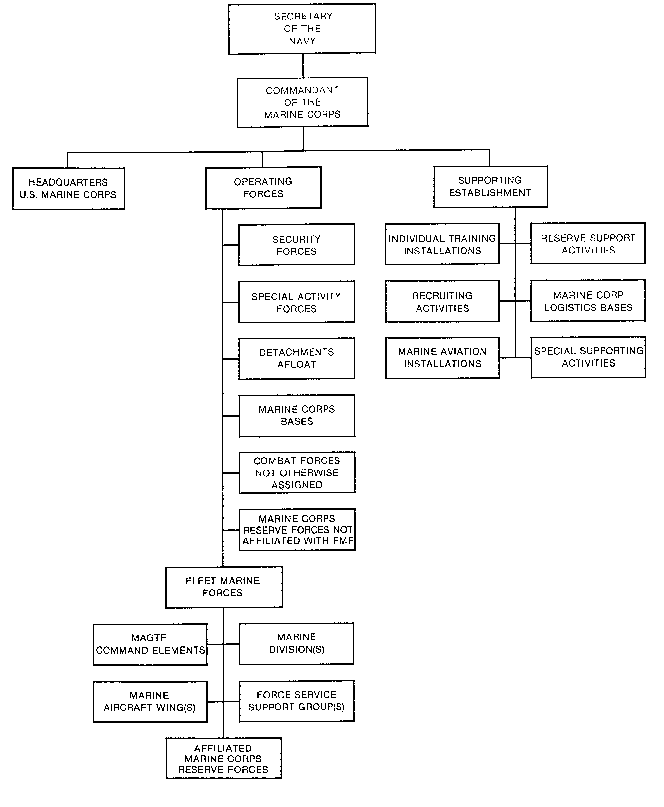
Figure 1 - Organization of the Marine Corps
OS-506 -- US Marines
LESSON OBJECTIVES
506.1 Comprehend the capabilities and limitations of US military forces [I.1 (a)].
506.11 Describe the roles and missions of the US Marine Corps.
HISTORY:
Marine Corps Roles and Missions (FMFM 1-2)Version #1
Marine Corps composition and functions are detailed in 10 S. C. 5063: The Marine Corps, within the Department of the Navy, shall be so organized as to include not less than 3 combat divisions and 3 aircraft wings, and such other land combat, aviation, and other services as may be organic therein.
The Marine Corps shall be organized, trained, and equipped to provide Fleet Marine Forces of combined arms, together with supporting air components, for service with the fleet in the seizure or defense of advanced naval bases and for the conduct of such land operations as may be essential to the prosecution of a naval campaign.
In addition, the Marine Corps shall provide detachments and organizations for service on armed vessels of the Navy, hall provide security detachments for the protection of naval property at naval stations and bases, and shall perform such other duties as the President may direct. However, these additional duties may not detract from or interfere with the operations for which the Marine Corps is primarily organized.
The Marine Corps shall develop, in coordination with the Army and the Air Force, those phases of amphibious operations that pertain to the tactics, techniques, and equipment used by landing forces.
The Marine Corps is responsible, in accordance with integrated joint mobilization
plans, for the expansion of peacetime components of the Marine Corps to meet the needs
of war.
Department of Defense Directive 5100.1 expands on the statutory guidance for Marine Corps primary combatant functions as follows (note: These functions do not contemplate the creation of a second land Army):
And for the Navy and Marine Corps:
Additionally, Department of Defense Directive 5100.1 defines collateral functions for all Services. The collateral functions of the Navy and the Marine Corps are to train forces to:
Joint Pub. 0-2, Unified Action Armed Forces (UNAAF), provides additional amplification regarding Marine Corps responsibilities, which include:
The Marine Corps Manual adds three additional functions:
Accordingly, Marine operating forces must be prepared for:
Roles and Functions (as per 506.ppt) Version
#2
Provide:
Develop:
Perform:
Such other duties as the president may direct
506.12 Describe the organization of the US Marine Corps.

Figure 1 - Organization of the Marine Corps
506.13 Describe the expeditionary capabilities of the US Marine Corps.
Fleet Marine Forces Responsibilities and Relationships
The Fleet Marine Forces are integral parts of the United States Fleets or naval forces to which assigned. They have the status of a fleet type command and are subject to the operational control of the respective fleet commanders except for individual and unit training, control of which is retained by the Commandant of the Marine Corps, who also exercises administrative control. The Commandants authority over the Fleet Marine Forces is described as command less operational control.
A Fleet Marine Force consists normally of a command element, appropriate command
support organizations, one or more divisions, one or more aircraft wings, and one or more
force service support groups. Forces assigned to one Fleet Marine Force and the unified
command of which the Fleet Marine Force is part may not be reassigned to another without
approval of the National Command Authorities. The specific missions of the Fleet Marine
Forces are:
Marine Air Ground Task Forces (MAGTF) are Organized for combat:
All organizations have one of the following:
Normal MAGTF organizations:

Marine Expeditionary Force (MEF)
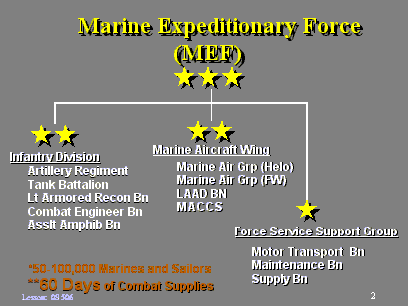
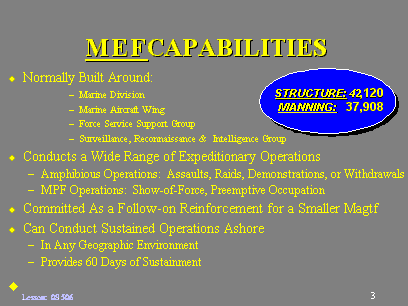
How many Active MEFs? 3 (1 MEF, II MEF, III MEF):
How many reserve MEFs? 1 (4th MEF)
IMEF: (Active)
HQ Section (1stMADIV) @ Camp Pendleton, CA
1st Marine Division (1st MARDIV) @ Camp Pendleton
3rd Marine Aircraft Wing (3rd MAW) @ EL Toro, CA
1st Service Support Group (1st FSSG) & Camp Pendleton, CA
IIMEF: (Active)
HQ Section (2ndMADIV) @ Camp Lejune, NC
2nd Marine Division (2nd MARDIV) @ Camp Lejune, NC
2nd Marine Aircraft Wing (2nd MAW) @ Cherry Point, NC
2nd Service Support Group (2nd FSSG) @ Camp Lejune, NC
IIIMEF: (Active)
HQ Section (3rdMADIV) @ Okinawa, Japan
3rd Marine Division (3rd MARDIV) @ Okinawa, Japan
1st Marine Aircraft Wing (1st MAW) @ Okinawa, Japan
3rd Force Service Support Group (3rd FSSG) @ Okinawa, Japan
IV MEF: (Reserve)
HQ Section (4thMADIV) @ New Orleans, LA
4th Marine Division (4th MARDIV) @ New Orleans, LA
4th Marine Aircraft Wing (4th MAW) @ New Orleans, LA
4th Force Service Support Group (4th FSSG) @ Atlanta, GA
Marine Expeditionary Force (Forward) **Brigade sized
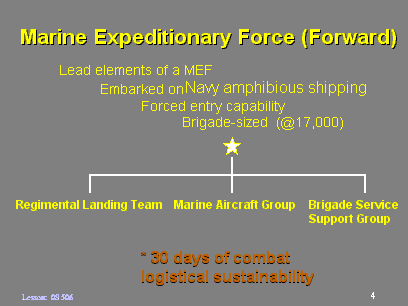
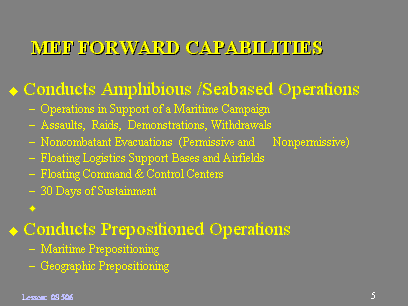
How many MEFs (FWD "MEBs"? 0 (only constructed as needed)
Marine Expeditionary Unit (MEU)
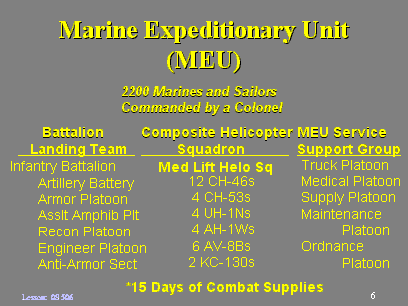
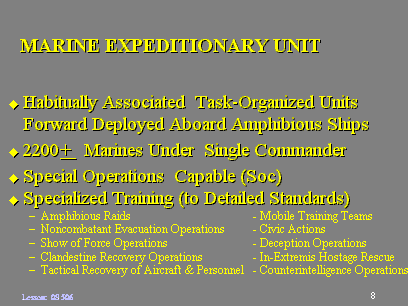
How many MEUs?---seven
11th,13th,15th----West Coast
22nd, 24th, 26th --East Coast
31st-------------Okinawa
MEU (SOC) SPECIAL OPERATIONS:
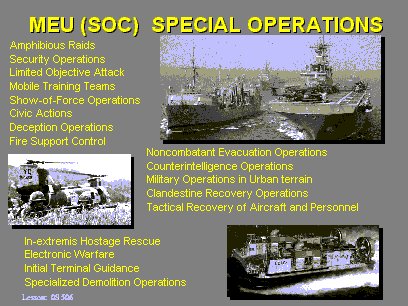
RECENT OPERATIONS
506.14 Describe the unique capabilities the Marine Air-Ground Task Force provides
a theater commander.
506.15 Describe how the Marine Corps employs organic Marine air assets.
Marines employ their organic air assets within their assigned MAGTF under the authority of their assigned CinC (i.e. CinCPacFlt).
Six Functions of Marine Aviation:
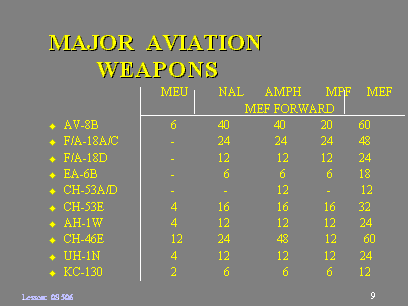
506.2 Comprehend the relationship between Service doctrine and joint doctrine
[I.2(d)].
506.21 Describe how the Marine Corps organization is designed to support the US
National Military Strategy and objectives.
Fleet Organization

Figure 2 - Fleet Organization
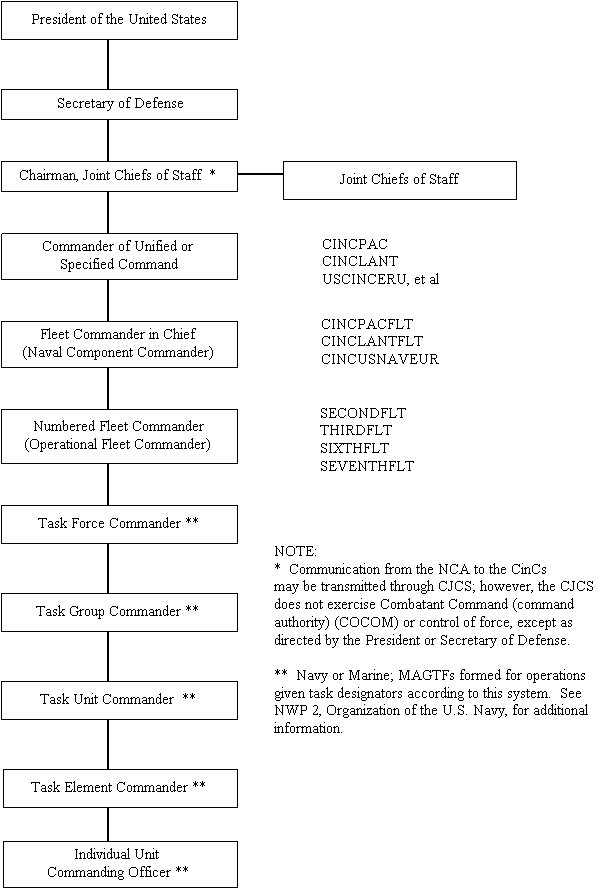
Figure 3 - Operational Organization of the Operating Forces
Fleet Marine Forces Responsibilities and Relationships
The Fleet Marine Forces are integral parts of the United States Fleets or naval forces to which assigned. They have the status of a fleet type command and are subject to the operational control of the respective fleet commanders except for individual and unit training, control of which is retained by the Commandant of the Marine Corps, who also exercises administrative control. The Commandants authority over the Fleet Marine Forces is described as command less operational control.
A Fleet Marine Force consists normally of a command element, appropriate command support organizations, one or more divisions, one or more aircraft wings, and one or more force service support groups. Forces assigned to one Fleet Marine Force and the unified command of which the Fleet Marine Force is part may not be reassigned to another without approval of the National Command Authorities. The specific missions of the Fleet Marine Forces are:
506.22 Explain how the Marine Corps envisions the employment of the Marine Corps
Air-Ground Task Force in support of a theater campaign today.
In particular interest to the naval Services is the fact that some 60 percent of politically significant urban areas (those whose political/economic activity have warranted establishment of a U.S. embassy, legation, or other U.S. agency) outside allied or former Warsaw Pact territory are located along or within 25 miles of a coastline; 75 percent are within 150 miles of the sea, 87 percent within 300 miles, 95 percent within 600 miles, and all within 800 miles. While urban areas provide significant advantages to a prepared defender, they are exceedingly vulnerable to surprise attack. The 1940 German coup de main at Copenhagen and occupations of Narvik, Trondheim, Bergen, Kristiansand, and Oslo with light forces and air and naval support essentially paralyzed Danish and Norwegian response. Those efforts as well as Soviet military actions in Budapest (1956), Prague (1968), and Kabul (1980) underscore the importance of rapid seizure of the political and economic center of gravity of a nation-state. In each of these cases, that occupation was the prelude to occupation of the country as a whole, a policy which, in the case of the Danish, Norwegian, and Afghan situations, created significant problems for the occupier further downstream.
Nonetheless, as a military act to achieve paralysis of governmental and significant military response, they were a successful. How that success is exploited requires as much careful planning, both political and military, as the initial intervention itself. While the United States has also employed urban intervention operations, they differ in that there was never an intention to remain in permanent possession. Military force was employed to support a limited political objective and then was withdrawn.
Urban intervention operations of necessity must often be planned and executed in a matter of hours and days (rather than weeks or months) to take advantage of the internal turmoil surrounding a developing crisis before opposing political and military power is consolidated. Such operations embassy defense, evacuations, friendly government reinforcement, coup de main in urban areas will require an entirely different approach than set-piece urban operations normally encountered in conventional land warfare. Urban terrain provides significant advantages to the defending force; accordingly, surprise occupation of the vital area necessary for mission accomplishment, and the areas controlling the approaches to that vital area, is the key if resistance is anticipated. In that fashion, the defensive advantages accrue to the occupier, and the resident opposition is obliged to organize a response to dislodge the intervening forces.
While urban terrain may be the most probable for political reinforcement operations, it is by no means exclusively so. The wide range of missions which may be assigned for policy reinforcement can dictate diverse tactical requirements and restrictions, environmental considerations, and duration of commitment. Each must be planned and executed within the framework of U.S. strategic objectives, allied support, local and worldwide opposition, and politico-military restrictions existent at the time of the crisis. Clear-cut mission analysis, thorough intelligence, unit discipline, and coordination with U.S. diplomatic efforts are the keys to success. In summary, political reinforcement is the most probable commitment that the Fleet and its Marines can anticipate from day-to-day and year-to-year. Both the nations history and current trends underscore that. As part of the Fleet (10 U.S.C. 5063), the Marine Corps responsibility for and contribution to political reinforcement is well established. This requires the capability for both measured and decisive employment of afloat-deployed Marine forces as well as
for their rapid reinforcement by air and sealifted forces. Accordingly, afloat forward-deployed Marine forces should be capable of performing the following, either unilaterally or as part of a larger follow-on force:
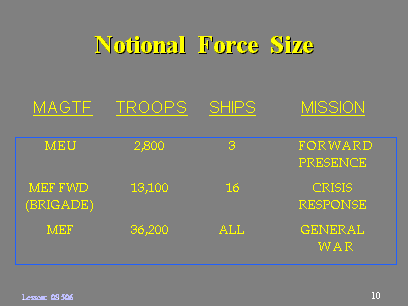
506.23 Explain how the Marine Corps envisions the employment of the Marine Corps
Air-Ground Task Force in support of a theater campaign in the future.
Today and for the future, Marine Corps roles and missions must be reviewed in the context of the evolving world scene; adaptation must be predicated on the strategic needs of the nation and the tactical and logistical wherewithal to meet them. Adaptation also requires a review of current practice in order to preserve proven approaches which continue valid.
The Marine Corps roles and missions in todays strategic context highlight the following operational tasks, stated and derived, for which the Marine Corps is expected to focus force and doctrine development as well as associated training:
Each Service structures and trains for unique and distinctly separate tasks. However,
there is considerable latitude for employment of forces. According to Joint Pub 0-2, the
forces developed and trained to perform the primary functions assigned to one Service by
the Functions Paper shall be employed to support and supplement the other Services in
carrying out their primary functions wherever and whenever such participation will result
in increased effectiveness and will contribute to the accomplishment of the overall
military objectives.
Course Objectives
1. Comprehend the capabilities and limitations of US military forces across the range of military operations, to include command relationships, force development and organization, and the concepts of deployment, employment, sustainment, and redeployment (OPMEP Learning Area 1).
READINGS
OPTIONAL READINGS (non-testable material):
For more information on current Marine issues, we suggest you visit the following web site:
Marine Homepage (www.usmc.mil)
READING RATIONALE
FMFM 1-2 discusses, in general terms, the strategic environment, organization, and purpose
of the Marine Corps.
The toolbooks provide a basic understanding of the combined arms warfare concept used by the Marine Corps and the composition, employment, roles, and missions of the Marine Corps expeditionary units.
The Linn and Neimeyer article reviews the historical employment of the Marine Corps and addresses the need for the continued existence of the Marine Corps in order to meet future national security objectives.
LESSON OUTLINE
Thesis: United States Marine Corps forces provide the National Command Authority and theater commanders with unique capabilities for rapid response to a wide variety of crises. Full understanding of the roles, missions, and capabilities of the US Marine Corps is essential to the joint staff operational and campaign planners in responding to regional crises that arise around the world.
Main Point I: Review and discuss the roles, missions, capabilities, doctrine, and force structure used by the US Marine Corps to support the National Security Strategy, National Military Strategy, and theater commanders objectives.
Main Point II: Review and discuss the future roles, missions, capabilities,
doctrine, and force structure that may be used by the US Marine Corps into the 21st
century.
LESSON INTEGRATION AND RATIONALE
This lesson presents the basic elements of the roles and missions, doctrine, strategy, and
force structure used by the United States Marine Corps to execute the National Security
Strategy, National Military Strategy, and theater commanders objectives. This lesson is
one of the required cornerstones for understanding joint military operations and planning.
Concepts and knowledge gained in this lesson will be applied in the Air Campaign, Joint
Operations and Force 2025 courses as well as in the Joint Warrior Wargame and operational
exercises used to support the overall curriculum.
LESSON OPR: War/Theater Level Studies Department